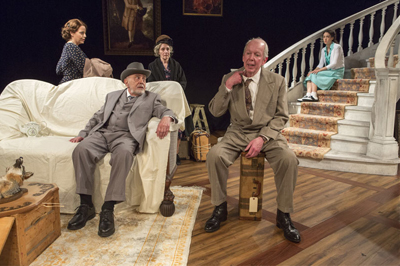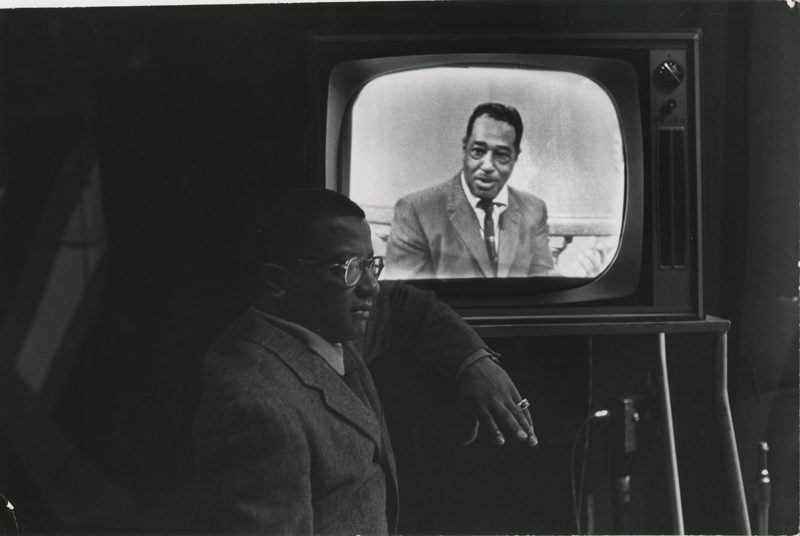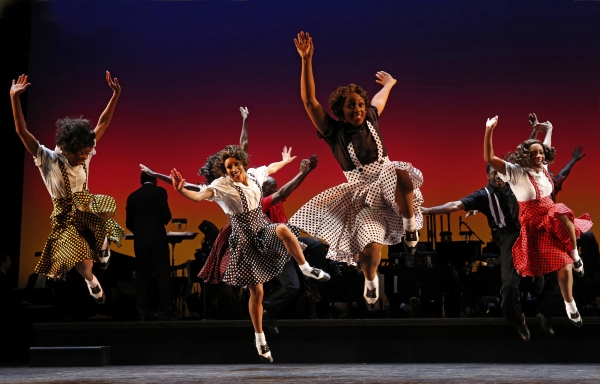In today’s Wall Street Journal drama column I report on two important revivals in New York and Massachusetts, the Mint Theater Company’s A Picture of Autumn and Barrington Stage’s On the Town. Here’s an excerpt.
* * *
 If you’ve ever wondered how much damage a drama critic can do, consider the case of N.C. Hunter. In the Fifties he was one of England’s best-known playwrights, the author of school-of-Chekhov domestic dramas of middle-class loss and uncertainty that embodied the nagging anxieties of postwar audiences. Then Kenneth Tynan went to work on him with a rubber hose, sneering at “the vacuity of [his] attitude towards life” and dismissively comparing him to the angry-young-man playwrights like John Osborne whom Tynan saw as the salvation of British theater. Result: Hunter’s plays slipped from sight. The Mint Theater Company’s Off-Broadway revival of “A Picture of Autumn” is one of a bare handful of Hunter productions to be presented in this country since “A Day by the Sea” was seen on Broadway in 1955.
If you’ve ever wondered how much damage a drama critic can do, consider the case of N.C. Hunter. In the Fifties he was one of England’s best-known playwrights, the author of school-of-Chekhov domestic dramas of middle-class loss and uncertainty that embodied the nagging anxieties of postwar audiences. Then Kenneth Tynan went to work on him with a rubber hose, sneering at “the vacuity of [his] attitude towards life” and dismissively comparing him to the angry-young-man playwrights like John Osborne whom Tynan saw as the salvation of British theater. Result: Hunter’s plays slipped from sight. The Mint Theater Company’s Off-Broadway revival of “A Picture of Autumn” is one of a bare handful of Hunter productions to be presented in this country since “A Day by the Sea” was seen on Broadway in 1955.
Never having seen or read a Hunter play, I was curious to find out whether he deserved Tynan’s abuse. Not a bit of it: “A Picture of Autumn” is impressive in every way, and the Mint’s staging, directed with quiet intelligence by Gus Kaikkonen and acted by a top-drawer ensemble cast, is so strong that in a perfect world it would trigger a general revival of interest in Hunter’s work.
Written and set in 1951, “A Picture of Autumn” is a group portrait of the Denhams, a trio of cash-strapped aristocrats (Jonathan Hogan, George Morfogen and Jill Tanner) who live in a moldering country house that they can no longer afford to keep up. All of them are growing frail and one is on the brink of senility. The oldest son (Paul Niebanck), a civil servant who has put his upper-class ways behind him, longs to move them into a modern flat, but the family’s memories of “the old days, when we had cooks and things” remain so vivid that they can’t imagine leaving.
In 1951 “A Picture of Autumn” was received by British playgoers as a study of a once-privileged class in decline. Six decades later, Americans who are trying to figure out how best to care for their own parents are more likely to give it an up-to-date spin. Either way, the Denhams’ plight is stingingly bittersweet…
 “On the Town” made stars out of Leonard Bernstein, Betty Comden, Adolph Green and Jerome Robbins when it opened on Broadway in 1944, running for 462 performances. They stayed famous–but the show didn’t. It’s never been successfully revived in New York, nor does it get done regionally save on rare occasions. So I’m thrilled to report that Barrington Stage is putting on a production directed by John Rando (“All in the Timing”) that is more than exciting enough to make you scratch your head in puzzlement. How could so exhilarating a musical have slipped through the cracks?…
“On the Town” made stars out of Leonard Bernstein, Betty Comden, Adolph Green and Jerome Robbins when it opened on Broadway in 1944, running for 462 performances. They stayed famous–but the show didn’t. It’s never been successfully revived in New York, nor does it get done regionally save on rare occasions. So I’m thrilled to report that Barrington Stage is putting on a production directed by John Rando (“All in the Timing”) that is more than exciting enough to make you scratch your head in puzzlement. How could so exhilarating a musical have slipped through the cracks?…
“On the Town” doesn’t work without very well-made choreography, and Joshua Bergasse, who staged the dances for “Smash,” delivers the goods in abundance. Though some of his moves are explicitly Robbinsesque, the comic numbers are fresh enough to make you wonder why his work has yet to be seen on Broadway. Mr. Rando is, of course, universally and deservedly admired–he directed the brilliant “Guys and Dolls” that Barrington Stage mounted two years ago–and the members of his youthful cast, especially Deanna Doyle, Alysha Umphress and Tony Yazbeck, collectively slam it out of the park….
* * *
Read the whole thing here.
Highlights from Barrington Stage’s On the Town:

 Just the other day Kathy sent me a link to an online album of some three hundred-odd snapshots showing David hard at work on 713 Hickory Drive. I haven’t been back to Smalltown since my mother’s funeral, and I was thrilled to see the step-by-step transformation of the house into an up-to-date residence more perfectly suited to the needs of its happy new occupants. While I felt an occasional pang of sentiment as I looked at the pictures–after all, I grew up there–it’s far more important to me to know that David and Kathy want not merely to keep the house in the family but to bring it back it to life.
Just the other day Kathy sent me a link to an online album of some three hundred-odd snapshots showing David hard at work on 713 Hickory Drive. I haven’t been back to Smalltown since my mother’s funeral, and I was thrilled to see the step-by-step transformation of the house into an up-to-date residence more perfectly suited to the needs of its happy new occupants. While I felt an occasional pang of sentiment as I looked at the pictures–after all, I grew up there–it’s far more important to me to know that David and Kathy want not merely to keep the house in the family but to bring it back it to life. At any rate, I expect I’ll go to my grave knowing that the Teachout family’s phone number was 471-3319 (formerly GR1-3319). No doubt I’d do better to know any number of more useful things, but usefulness, like goodness, has nothing to do with it. In the words of the contestants in The 25th Annual Putnam County Spelling Bee, Life is random and unfair/That’s the reason we despair/Life is pandemonium.
At any rate, I expect I’ll go to my grave knowing that the Teachout family’s phone number was 471-3319 (formerly GR1-3319). No doubt I’d do better to know any number of more useful things, but usefulness, like goodness, has nothing to do with it. In the words of the contestants in The 25th Annual Putnam County Spelling Bee, Life is random and unfair/That’s the reason we despair/Life is pandemonium. Of making books there is no end, saith the preacher, and much study is a weariness of the flesh. The latter is true, the former less so. I sent in my final corrections to the text of
Of making books there is no end, saith the preacher, and much study is a weariness of the flesh. The latter is true, the former less so. I sent in my final corrections to the text of  There will, of course, be bad news–there always is–but I’m hopeful that Duke will be received with at least some of the same enthusiasm that greeted Pops in 2009. I doubt it’ll hurt that After Midnight, an all-Ellington revue, will be opening on Broadway two weeks after Duke hits the book stores, an exceedingly fortuitous piece of timing.
There will, of course, be bad news–there always is–but I’m hopeful that Duke will be received with at least some of the same enthusiasm that greeted Pops in 2009. I doubt it’ll hurt that After Midnight, an all-Ellington revue, will be opening on Broadway two weeks after Duke hits the book stores, an exceedingly fortuitous piece of timing.